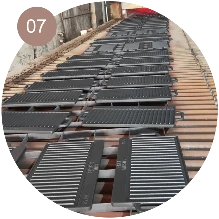
Cast Iron Cookware for Perfectly Even Heat Distribution and Delicious Meals
The Evolution of Cast Saucepan A Culinary Essential
When it comes to kitchen essentials, few items can boast the enduring appeal and versatility of the cast saucepan. Often regarded as a culinary workhorse, the cast saucepan has a rich history that has evolved over centuries, adapting to the changing needs of home cooks and professional chefs alike.
Historical Context
The origins of cast iron cookware can be traced back to ancient times, with evidence of cast iron being used in China during the 5th century BC. The material found its way to Europe by the 14th century, where it gained popularity among affluent households for its durability and ability to retain heat. The cast saucepan, in particular, became a staple in kitchens, allowing cooks to prepare a variety of dishes, from stews to sauces, with consistent results.
The Material Science
What sets cast saucepans apart from their counterparts made of other materials, such as stainless steel or non-stick coatings, is the unique properties of cast iron. The material is known for its exceptional heat retention, allowing for even cooking and browning of food. This characteristic is particularly advantageous when cooking sauces that require a slow simmer, as it helps to prevent scorching and promotes the melding of flavors.
Additionally, cast iron distributes heat evenly across its surface, reducing the likelihood of hot spots that can lead to uneven cooking. This feature becomes especially important when making delicate sauces that rely on precise temperature control.
cast saucepans

Versatility in the Kitchen
A cast saucepan is not only adept at sauce-making but also proves to be versatile in a variety of cooking methods. It can be used on the stovetop and transferred to the oven, making it ideal for recipes that require both searing and baking. Cooks can start a dish on the stovetop to develop flavor, then finish it in the oven for a perfectly cooked result.
Moreover, cast saucepans can handle high temperatures, allowing users to achieve that coveted caramelization for sauces and gravies. They also transition beautifully from kitchen to table, bringing a rustic elegance that enhances the dining experience.
Care and Maintenance
While cast saucepans offer remarkable durability, they do require special care to maintain their non-stick surface and prevent rust. Seasoning is essential; the process involves coating the saucepan with oil and heating it to create a natural non-stick layer. With proper maintenance, a cast saucepan can last for generations, becoming a cherished heirloom that tells the story of countless meals and family gatherings.
Conclusion
The cast saucepan is more than just a cooking tool; it is a testament to the art of home cooking and culinary tradition. Its ability to enhance flavors, withstand high heat, and serve multiple cooking functions has solidified its place in kitchens around the world. As trends in cooking continue to evolve, the cast saucepan remains a timeless essential, ready to assist in creating delicious, comforting meals for years to come. Whether you’re a novice cook or a seasoned chef, investing in a quality cast saucepan is a decision that will undoubtedly elevate your culinary adventures.
-
Cast Iron Cookware Pancake Pan- ZD Cookware|Non-Stick, Even Heat, DurableNewsAug.02,2025
-
Cast Iron Cookware- Baixiang County Zhongda Machinery|Non-Stick, Heat RetentionNewsAug.02,2025
-
High Quality Kitchen Durable Black Round Cast Iron Cookware Pancake Crepe Pan With Wooden Handle|Non-Stick Surface&Heat RetentionNewsAug.02,2025
-
Authentic Traditional Chinese Wok for High-Performance CookingNewsAug.02,2025
-
Season Cast Iron Perfectly with GPT-4 Turbo TipsNewsAug.01,2025
-
High Quality Cast Iron Cookware - Baixiang County Zhongda MachineryNewsAug.01,2025


